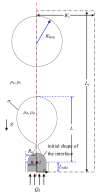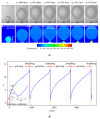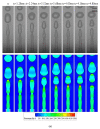Dripping, Jetting and Regime Transition of Droplet Formation in a Buoyancy-Assisted Microfluidic Device
- PMID: 33121113
- PMCID: PMC7693404
- DOI: 10.3390/mi11110962
Dripping, Jetting and Regime Transition of Droplet Formation in a Buoyancy-Assisted Microfluidic Device
Abstract
Buoyancy-assisted droplet formation in a quiescent continuous phase is an effective technique to produce highly monodispersed droplets, especially millimetric droplets. A comprehensive study combining visualization experiment and numerical simulation was carried out to explore the underlying physics of single droplet generation in a buoyancy-assisted microfluidic device. Typical regimes, including dripping and jetting, were examined to gain a deep insight into the hydrodynamic difference between the regimes. Particularly, the transition from dripping regime to jetting regime was investigated to give an in-depth understanding of the transitional behaviors. The effects of interfacial tension coefficient on the droplet size and formation regimes are discussed, and a regime diagram is summarized. The results show that oscillation of the interface in dripping regimes after detachment is caused by the locally accelerated fluid during the neck pinching process. Droplet formation patterns with the characteristics of both dripping regime and jetting regime are observed and recognized as the transitional regime, and the interface oscillation lasts longer than that in dripping regime, implying intensive competition between interfacial tension and inertial force. Reducing interfacial tension coefficient results in the dripping-to-jetting transition occurring at a lower flow rate of the dispersed phase. The regime diagram indicates that only the inertial force is the indispensable condition of triggering the transition from dripping to jetting.
Keywords: buoyancy; droplet formation; interfacial tension; microfluidic.
Conflict of interest statement
The authors declare no conflict of interest.
Figures













Similar articles
-
High inertial microfluidics for droplet generation in a flow-focusing geometry.Biomed Microdevices. 2019 Jun 15;21(3):50. doi: 10.1007/s10544-019-0405-x. Biomed Microdevices. 2019. PMID: 31203430
-
Emulsion droplet formation in coflowing liquid streams.Phys Rev E Stat Nonlin Soft Matter Phys. 2013 Jan;87(1):013002. doi: 10.1103/PhysRevE.87.013002. Epub 2013 Jan 3. Phys Rev E Stat Nonlin Soft Matter Phys. 2013. PMID: 23410421
-
Mode Transition of Droplet Formation in a Semi-3D Flow-Focusing Microfluidic Droplet System.Micromachines (Basel). 2018 Mar 21;9(4):139. doi: 10.3390/mi9040139. Micromachines (Basel). 2018. PMID: 30424073 Free PMC article.
-
SAW-driven droplet jetting technology in microfluidic: A review.Biomicrofluidics. 2020 Dec 9;14(6):061505. doi: 10.1063/5.0014768. eCollection 2020 Nov. Biomicrofluidics. 2020. PMID: 33343781 Free PMC article. Review.
-
Fluid Ejections in Nature.Annu Rev Chem Biomol Eng. 2024 Jul;15(1):187-217. doi: 10.1146/annurev-chembioeng-100722-113148. Epub 2024 Jul 3. Annu Rev Chem Biomol Eng. 2024. PMID: 38669514 Free PMC article. Review.
Cited by
-
Microfluidic Chip Device for In Situ Mixing and Fabrication of Hydrogel Microspheres via Michael-Type Addition.Langmuir. 2021 Oct 12;37(40):11793-11803. doi: 10.1021/acs.langmuir.1c01739. Epub 2021 Oct 1. Langmuir. 2021. PMID: 34597052 Free PMC article.
References
-
- Lan K., Liu J., Li Z., Xie X., Huo W., Chen Y., Ren G., Zheng C., Yang D., Li S., et al. Progress in octahedral spherical hohlraum study. Matter Radiat. Extrem. 2016;1:8–27. doi: 10.1016/j.mre.2016.01.003. - DOI
-
- Vladisavljevic G.T., Kobayashi I., Nakajima M. Production of uniform droplets using membrane, microchannel and microfluidic emulsification devices. Microfluid. Nanofluid. 2012;13:151–178. doi: 10.1007/s10404-012-0948-0. - DOI
-
- Luo Z.Y., Bai B.F. Dynamics of capsules enclosing viscoelastic fluid in simple shear flow. J. Fluid Mech. 2018;840:656–687. doi: 10.1017/jfm.2018.88. - DOI
Grants and funding
LinkOut - more resources
Full Text Sources

